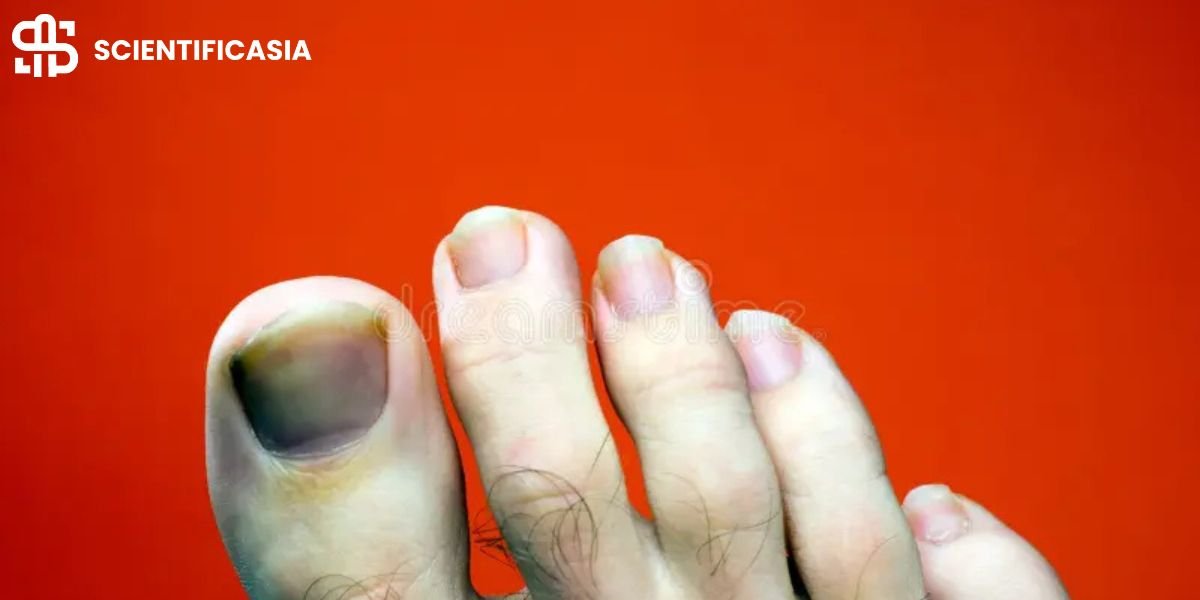Introduction
Why did my toenail fall off without pain? This question might seem surprising, but detached toenails are common, although they can be painful. Psoriasis, fungal infections, or injuries are the main causes. But major illnesses, chemicals, and some drugs can also cause toenail falling off.
Once your toenail fell off, it cannot reattach by itself. Until the new nail grows back in its place, you will have to wait. Depending on the reason and the amount of toenail left, you may require additional treatment to ensure your toenail grows back properly.
Following some safety precautions will help avoid further harm or infection if your toenail fell off no pain, completely or in part. The doctor might recommend additional treatment options depending on the underlying cause.
Causes: Why did my toenail fall off without pain?
Several factors, including underlying medical issues and toe injuries, can cause a toenail to come off. Understanding the causes behind why are my toenails falling off might help you identify the root of the problem and decide whether to seek medical attention.
1. Trauma or Injury
One of the most common reasons for toenail falling off is physical trauma. The toenail may split from the nail bed due to injuries like stubbing your toe, dropping a heavy object on it, or constant pressure from activities like jogging or improperly fitted shoes.
Trauma can cause blood to collect beneath the nail, resulting in a dark purple or black discoloration called a subungual hematoma. This increases pressure, which can ultimately result in the toenail fell off.
The following are other signs of trauma-induced toenail falling off:
- The injured toe experiences throbbing pain at the time of damage or after repeatedly applying pressure.
- Pain gets worse as blood gathers behind the nail.
- Swelling in the toe area
- There is tenderness when walking or touching your toes.
2. Onycholysis
People often lose their toes because of onycholysis. Onycholysis may result from an injury in some individuals or from an allergy to a nail product (such as nail paint remover or artificial nail tips).
Onycholysis can sometimes happen as a result of psoriasis or nail fungus. Additionally, it may be a sign of a yeast infection or thyroid condition.
Onycholysis takes longer to develop, in contrast to toe damage. As a result, the symptoms emerge gradually and frequently go unnoticed. Possible signs include:
- Thickening or discoloration of the nail.
- Debris accumulates and begins to dislodge beneath the nail.
- Usually, there will be a white discoloration where the nail begins to split from the nail bed.
- However, if a bacterial or fungal infection is the cause of the nail loosening, you will notice a dark brown or greenish discoloration.
3. Fungal Infections (Dermatophytes)
The most common cause why does my toenail keep falling off is dermatophytes, a fungal infection. Dermatophytes like warm, wet conditions and feed on the keratin present in the skin and nails. When toenail fungus develops, the nails may become extremely brittle, increasing the possibility that they may crack or split. The fungal growth can also spread between the nail and the nail bed, causing the toenail to separate and eventually fall out.
Fungal infections of the nail (known as onychomycosis) occur when fungi or yeasts grow in and around it. It usually starts on the feet and moves to the toenail(s), causing signs like:
- The side of the nail has yellow or white streaks.
- Green or yellow nail discoloration
- Brittleness
- The nail’s outer edges exhibit flakiness.
- Thick nails
- There is pain, itching, or discomfort around the nail bed.
- Distorted or irregular nail shape
- A toenail lifts away from the nail bed.
Nail fungus may affect anybody, although it is more common in older persons and people with diabetes, poor circulation, weak immune systems, and psoriasis.
4. Nail Psoriasis
Psoriasis is a chronic autoimmune disorder that occurs when an overactive immune system causes skin cells to grow too fast. This results in itchy plaques of thick, blistering, or inflamed skin. Psoriasis first affects the skin, but about half of people who have it eventually develop it on their nails years after their psoriasis symptoms began.
Nail psoriasis can cause the following symptoms to appear in toenails:
- The nail surface may have pits or dentations.
- The nails exhibit brown or yellow discoloration.
- Rough and thick nail texture
- The nail bed separates from the nail.
- The nails exhibit irregular or misshapen features.
- Walking and other physical activities may be challenging due to pain and soreness.
5. Eczema
Eczema is a collection of inflammatory skin disorders that can result in scaly areas of skin or dry, itchy rashes. Additionally, eczema can lead to changes and loss of fingernails and toenails.
This disorder can cause the skin surrounding the nails to become dry, itchy, and inflammatory, weakening the nails and making them brittle and easily breakable. Eczema, which affects the nail matrix, can cause you to lose all of your nails without experiencing any pain.
Additional signs of toenail problems associated with eczema include:
- The skin around your toenail may be scaly, red, or itchy.
- The nails are weak, fragile, or broken.
- There is tenderness and redness surrounding the affected area.
6. Subungual Exostosis
A subungual exostosis is a bony growth that develops beneath the toenail, usually near the tip of the toe.
Long-term irritation or stress, such as pressure from poorly fitting shoes or minor cuts, typically causes this condition. It may also be genetic.
As the exostosis grows, it can exert pressure on the toenail’s bottom, eventually separating it from the nail bed. As a result, the toenails may become loose and finally fall off.
Surgical removal of the exostosis typically relieves pressure and allows the toenail to regrow normally.
7. Impact of Poor Footwear
Another common cause for those individuals concerning why did my toenail fall off without pain is wearing the wrong shoes. Nail damage can result from tight or poorly fitted shoes. Wearing poorly fitted shoes for extended periods of time at work or while participating in sports is a literal punishment for your feet.
When your nail sustains damage, particularly repeated injuries, it may bleed, leaving behind a dark red, purple, or black mark. As mentioned, bleeding pressure can loosen the nail.
Additionally, if your toenails are constantly rubbing against hard or poorly fitted shoes, you may not feel any bleeding, but the nail may become loose.
What Does a Toenail Falling Off Look Like?
Before a toenail falling off, you may observe the nail loosening from the nail bed, usually beginning at the tip and moving to the cuticle. It might seem like the nail is “floating” above the nail bed when it lifts. The build-up of air, dirt, and debris beneath the nail can cause the region to appear white, brown, or yellowish.
A toenail may grow thicker, damaged, brittle, discolored, or deformed just before it falls off. If the toenail is falling out due to a fungal infection, the surrounding skin may be red, inflamed, and sensitive. This separation of the toenail from the nail bed can also cause discomfort or sensitivity in the skin surrounding the nail. It’s normal to worry what happens if your toenail falls off, but losing a toenail normally doesn’t hurt. However, you might notice that the skin beneath it is thicker than usual.
What to do if toenail falls off?
There are a few things you can do instantly when your toenail falls off, no matter what caused it, to prevent further issues.
Let me give you some quick suggestions:
- Don’t attempt to remove the remainder of your toenail if only a portion of it has fallen off.
- Use nail tools to carefully cut off the detached part of your toenail so it doesn’t catch on your socks or clothes. If you are uncomfortable doing this on your own, your doctor can assist you.
- Make any sharp or jagged edges smooth using a nail file.
- After cleaning and removing any dirt from your toe, use an antibiotic cream.
- Apply a bandage to the place where your toenail fell off.
- If your toenail falls off completely or the surrounding tissue continues to bleed, get medical help ASAP.
Treatment Options for Toenail falling off
Your doctor will decide how to treat a toenail fell off no pain based on the cause of your signs and symptoms. Since it is impossible to reattach a detached toenail to the nail bed, the therapy focuses on maintaining the connection to the new nail growth. It may take up to 18 months for a new toenail to grow, so you need to be careful and continue your treatment plan.
What to do if toenail falls off and starts bleeding? Here are some treatment and preventative suggestions for toenails that have fallen off or are about to fall off:
- If required, use pain relief medicine. To assist in avoiding infection, you can apply an antibiotic ointment or cream to your cleaned toe. You can reduce pain by taking an over-the-counter medication like ibuprofen.
- Cover the toe with bandages. If the toenail hasn’t fallen off entirely, you can apply a bandage on your toe until it falls out. Once the nail has separated from the nail bed, you can also cover it with a bandage. Until the nail bed’s skin hardens, leave the bandage on for seven to ten days.
- Cut off the current nail. To prevent the nail from catching or ripping on socks or other objects, trim down any sharp nail edges.
- Soak your feet in cold water. You can soak your toes in cold water for 20 minutes every day.
- Raise your foot as high as you can. Elevating your foot will minimize toe swelling.
If your toenail problems are due to skin or autoimmune issues, you will need to address the underlying condition to determine whether your toenail condition improves. If you have an underlying medical issue and worried why did my toenail fall off without pain, your doctor may recommend a variety of lifestyle modifications, drugs, and treatments to enhance your general health.
How to Prevent Toenail Fell Off Issues?
Prevention is crucial, and it can save you from worrying about what happens if your toenail falls off. The following advice can assist you in preventing toenail issues:
- Make sure your feet are clean and dry, especially between your toes.
- If you see any cuts or scrapes, apply antibiotic ointment immediately.
- Keep your toenails cut straight across, without rounding the edges, and shorter than the tips of your toes.
- Avoid wearing shoes that are too tight or high heels, as they can cause pain in your toes.
- Wear moisture-wicking socks to keep moisture away from both your skin and nails.
- Wear sandals or flip-flops when going to public places like changing rooms and swimming pools.
- Do not share personal goods that might transmit fungal diseases, such as emery boards or nail clippers.
- Clean your nail clippers with rubbing alcohol, soap, and water.
- Do not use nail polish that contains irritating chemicals.
- At least once a month, examine your toenails for any changes in texture or appearance. If you see any, discuss the matter with your healthcare physician.
Taking these precautions, along with adopting oral antifungal drugs if necessary, will greatly reduce your chance of toenail fell off no pain and other toenail problems.
Final Remarks
Curious about why did my toenail fall off without pain? A toenail may fall off due to trauma or traumas, fungal infections, or underlying medical disorders such nail psoriasis or eczema. See a doctor, such as a podiatrist or dermatologist, if you suspect that your toenail falling off or is tearing out of the underlying skin. The sooner you seek expert treatment, the greater your chances of restoring your nail health and avoiding future toenail issues. Keep your newly lost nail clean, dry, and protected, and above all, be patient.
Frequently Asked Questions (FAQs)
Are there warning signs before a toenail falls off?
An injury to your toenail will undoubtedly cause you pain and discomfort. Additionally, there can be bleeding from or underneath the nail. You may notice that your toenail is loose and discolored. If you are in danger of losing a toenail due to a fungal infection, you will notice symptoms common with fungal toenail infections, such as:
- White, brown, or yellow discoloration
- Nail thickening
- Discharge
- An unpleasant smell
- And sometimes pain and swelling
What to do if toenail falls off without pain?
First of all, don’t panic. Even if your toenail falls off, it will grow back in 12 to 18 months. However, seeking treatment from a professional podiatrist can help preserve your toe while your nail grows back and prevent future infections.
Can I do anything to take care of a toenail fell off at home?
Clean your toe and use sterile gauze or bandages to preserve it. Schedule an appointment with your doctor or podiatrist if you have a fungal toenail infection or lost a toenail.
When to Contact a Healthcare Provider
Seeing a doctor is a smart idea if you’re worried why did my toenail fall off without pain? see any changes to your toenails, such as:
- A toenail may lift or fall off the nail bed
- Discoloration of the nails
- Nail thickening
- Increased redness or pain
- Swelling or oozing pus
- There are changes in nail texture, such as deep grooves, dents, or pits
- The shape of your nails changes
- Flaking, chalky, or brittle nails
If your toenail has fallen off or if you have questions about your feet or toes, Greater Washington Advanced Podiatry can assist you. They can develop a personalized approach to handle your issues and provide a free initial consultation.
















